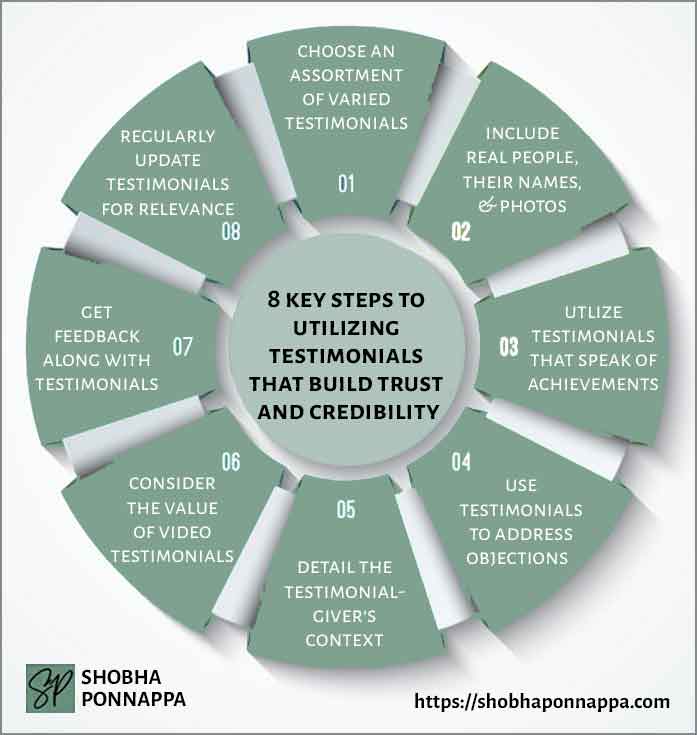
In brand marketing, trust and credibility reign supreme. Yet, in an era of skepticism and information overload, establishing and maintaining trust can be a daunting task.
Enter testimonials – the unsung heroes of credibility building, in the midst of fierce competition and uncompromising consumers.
These snippets of customer feedback offer a beacon of authenticity amidst the noise, showcasing real experiences and validating your brand’s promises.
However, in a sea of testimonials, standing out requires a strategic blend of the conventional and the unconventional. It’s not just about showcasing positive reviews; it’s about curating a collection that resonates deeply and leaves a lasting impression.
Testimonials serve as invaluable assets in the realm of brand trust and credibility. They provide tangible evidence of customer satisfaction, offering potential buyers reassurance and confidence in their purchasing decisions.
Unlike traditional marketing messages, testimonials carry a sense of authenticity and reliability, as they come directly from the voices of satisfied customers. In an era where consumers are inundated with advertising and marketing messages, testimonials cut through the noise by providing real-life experiences and outcomes.
They humanize brands, establishing an emotional connection that goes beyond product features or pricing. Furthermore, testimonials help to address common objections and concerns that prospective customers may have, ultimately smoothing the path to conversion.
By leveraging the power of testimonials, brands can build trust, enhance credibility, and differentiate themselves in a crowded marketplace, ultimately fostering long-term customer loyalty and advocacy.
In navigating the terrain of testimonials, the fusion of conventional and unconventional approaches becomes paramount, mirroring the essence of my “Unusual By Strategy” forte.
While conventional testimonials offer credibility through familiar means, the integration of unusual ideas injects a fresh perspective, capturing attention and resonating with audiences in unexpected ways. Embracing this duality not only aligns with your mandate of delivering unconventional solutions but also maximizes the impact of testimonials.
Conventional methods, such as written endorsements and star ratings, establish a foundation of trust, while unusual tactics, like video testimonials or storytelling formats, spark intrigue and emotional resonance. This hybrid approach ensures comprehensive coverage, catering to diverse audience preferences and amplifying the authenticity of brand messaging.
By championing a blend of proven and unusual testimonial strategies, brands can elevate their credibility, foster deeper connections with their audience, and ultimately carve a distinctive niche in the competitive landscape.
Leveraging my 40+ years’ experience as a Brand Content Strategist with a penchant for the unusual, I’ve curated eight ideas that blend time-tested approaches with innovative twists to optimize testimonials for building trust and credibility. These ideas encompass diverse strategies, from selecting diverse testimonials to utilizing video endorsements, each fortified with unconventional elements to enhance engagement and authenticity.
By marrying proven methodologies with unconventional tactics, brands can forge deeper connections with their audience, stand out in a crowded marketplace, and solidify their position as trustworthy industry leaders.

In content marketing, the strategic selection of a diverse range of testimonial types is a foundational practice for cultivating trust and credibility.
By incorporating testimonials from various sources, such as satisfied customers, industry experts, or influencers, brands can showcase a multifaceted endorsement of their products or services.
For instance, imagine a skincare brand featuring testimonials from dermatologists, beauty influencers, and everyday users, each highlighting different aspects of the product’s effectiveness and suitability for various skin types. This assortment not only amplifies the brand’s credibility by presenting a comprehensive endorsement but also caters to the diverse preferences and needs of potential customers.
Furthermore, by showcasing testimonials from different perspectives, brands can reinforce key messaging points and address potential objections, further solidifying their position as a trustworthy authority in the industry.

Consider the idea of “Narrative Testimonials.” Rather than traditional endorsements, encourage customers to share their experiences in the form of short stories or anecdotes. This approach adds depth and emotional resonance to testimonials, making them more compelling and memorable.
For instance, instead of a simple statement praising a skincare product, a customer could share a personal narrative detailing how the product transformed their skin and boosted their confidence. This narrative testimonial not only showcases the product’s effectiveness but also creates a deeper connection with potential customers by sharing a relatable and engaging story.
In content marketing, the incorporation of real people’s names and photos within testimonials serves as a cornerstone for fostering trust and credibility.
By humanizing testimonials in this manner, brands establish a tangible connection between their audience and satisfied customers, reinforcing the authenticity of their endorsements. For instance, imagine a fitness brand featuring a testimonial from Sarah, a real customer, alongside her photo and a brief description of her fitness journey.
Seeing Sarah’s smiling face and reading her story creates a relatable and trustworthy impression, encouraging potential customers to identify with her experience and consider the brand’s offerings. This personal touch not only adds credibility to the testimonial but also enhances the overall brand perception, positioning it as transparent and customer-centric.
By showcasing real people with their names and photos, brands can effectively leverage the power of storytelling to build meaningful connections and drive engagement with their target audience.

Consider the idea of “Animated Testimonials.” In addition to static photos, opt for animated illustrations or caricatures of customers alongside their testimonials. This unconventional approach adds a playful and eye-catching element to testimonials, increasing engagement and memorability. For instance, imagine the fitness brand representing customer Sarah with a charming animated character depicting her fitness journey, complete with dynamic movements and expressions.
This animated testimonial not only captures attention but also injects personality into the endorsement, making it more memorable and shareable across digital platforms. By embracing animated testimonials, brands can infuse creativity into their content strategy while maintaining the authenticity of real customer experiences.
In content marketing, leveraging testimonials to highlight achieved results stands as a tried-and-true method for building trust and credibility. By showcasing tangible outcomes and success stories, brands provide concrete evidence of their products or services’ effectiveness, resonating with potential customers seeking real-world proof.
For instance, consider a software company featuring a testimonial from a client who increased their website traffic by 50% after implementing the company’s SEO tool. This testimonial not only validates the software’s capabilities but also demonstrates its potential impact on business growth.
By emphasizing achieved results in testimonials, brands not only bolster their credibility but also inspire confidence and motivation in their audience, compelling them to take action and engage with the brand further.
It’s through these compelling narratives of success that brands can truly differentiate themselves and forge lasting connections with their target audience.

Consider the idea of “Interactive Testimonials.” Instead of static content, create interactive testimonials that allow users to engage with the results firsthand. For instance, imagine a testimonial where users can input their own metrics and see how the product or service could potentially impact their business. This interactive element not only makes the testimonial more engaging but also empowers users to visualize the potential outcomes for their own situation.
In the example of the software company, users could input their current website traffic and see a simulated increase based on the results experienced by the featured client. This innovative approach not only showcases achieved results but also fosters a deeper level of connection and understanding with the audience.
In the realm of content marketing, incorporating testimonials that address objections serves as a strategic maneuver to build trust and credibility. By preemptively addressing potential concerns or hesitations that prospective customers may have, brands demonstrate transparency and authenticity, ultimately strengthening their credibility.
For example, consider a fitness supplement brand featuring a testimonial from a customer who initially had doubts about the product’s effectiveness due to previous negative experiences with similar supplements.
In their testimonial, the customer shares how the brand’s product surpassed their expectations and alleviated their concerns, addressing common objections about efficacy and reliability.
By highlighting testimonials that directly tackle objections, brands not only mitigate skepticism but also showcase their commitment to customer satisfaction and their willingness to address challenges head-on. This approach reassures potential customers, instilling confidence in the brand and increasing the likelihood of conversion.

Consider the idea of “Objection-Busting Testimonials.” Instead of simply addressing objections, feature testimonials that creatively debunk common misconceptions or hesitations in a lighthearted or unexpected manner. For example, imagine a testimonial where a customer initially doubted a fitness supplement’s effectiveness due to skepticism about the industry.
However, in their testimonial, they humorously narrate how they were proven wrong after noticing significant improvements in their energy levels and performance. This approach not only addresses objections but also adds a unique twist, making the testimonial more memorable and persuasive. By infusing humor or creativity into objection-busting testimonials, brands can effectively disarm skepticism and build trust with their audience.
In the content marketing space, providing details of the testimonial giver’s context is a fundamental strategy for building trust and credibility. By offering insights into the background, experiences, and circumstances of the individual providing the testimonial, brands enhance the authenticity and relevance of their endorsements.
For instance, imagine a skincare brand featuring a testimonial from a customer who struggled with acne for years before discovering the brand’s products. By sharing their journey, including their age, skin type, and specific challenges faced, this testimonial not only resonates with others who may be experiencing similar issues but also establishes the credibility of the endorsement.
Customers are more likely to trust testimonials when they can relate to the context of the person giving it, as it adds depth and legitimacy to their endorsement.
In essence, providing details of the testimonial giver’s context in testimonials serves as a powerful tool for connecting with the audience on a personal level and fostering trust in the brand’s offerings.

Consider the idea of “Timeline Testimonials.” Instead of providing static details, present testimonials that unfold over time, offering insights into the testimonial giver’s journey and progress. For example, imagine a skincare brand featuring a testimonial that showcases the customer’s skincare transformation through a series of progress updates, accompanied by photos and anecdotes at different stages.
This dynamic approach not only provides context but also captures the testimonial giver’s evolution, highlighting the product’s long-term effectiveness and fostering deeper trust and credibility. By incorporating timeline testimonials, brands can offer a compelling narrative that resonates with their audience and strengthens their connection to the brand’s offerings.
In content marketing, the special value of video testimonials has stood the test of time as a powerful tool for building trust and credibility. Video testimonials offer a unique opportunity to showcase the authenticity and sincerity of customer endorsements, allowing viewers to see and hear firsthand the emotions and enthusiasm behind the testimonial.
For example, imagine a fitness equipment brand featuring a video testimonial from a customer who shares their transformative fitness journey, complete with before-and-after footage and heartfelt narration.
The dynamic visuals and personal storytelling in the video not only captivate the audience but also leave a lasting impression, reinforcing the brand’s credibility and inspiring confidence in potential customers. Moreover, video testimonials have the potential to significantly increase engagement and shareability across digital platforms, amplifying the brand’s reach and impact.
By harnessing the special value of video testimonials, brands can effectively leverage the power of visual storytelling to connect with their audience on a deeper level and drive conversions.

Consider the idea of “Immersive Testimonials.” Rather than traditional video testimonials, create immersive experiences by incorporating virtual reality (VR) technology. For example, imagine a fitness equipment brand offering VR testimonials where viewers can virtually step into the shoes of satisfied customers, experiencing their fitness journeys firsthand.
This innovative approach not only provides a deeper level of engagement but also enhances the emotional impact of the testimonials, strengthening their effectiveness in building trust and credibility. By embracing immersive testimonials, brands can differentiate themselves and leave a lasting impression on their audience, ultimately driving greater brand loyalty and conversions.
In content marketing, the practice of obtaining testimonials from clients to include feedback has long been recognized as a cornerstone for building trust and credibility.
By soliciting feedback directly from satisfied customers, brands not only gather valuable insights into the strengths and weaknesses of their products or services but also demonstrate a commitment to transparency and continuous improvement.
For example, imagine a software company collecting testimonials that not only praise the usability and efficiency of their product but also provide constructive feedback on areas for enhancement, such as additional features or user interface improvements. By incorporating this feedback into their testimonials, the brand showcases their receptiveness to customer input and their dedication to delivering solutions that meet and exceed customer expectations.
In essence, leveraging client feedback within testimonials not only bolsters credibility by showcasing real customer experiences but also fosters a culture of collaboration and customer-centricity within the brand’s marketing efforts.

Consider the idea of “Feedback Stories.” Instead of traditional testimonials, create narrative-style feedback stories that provide a deeper understanding of clients’ experiences and insights. For example, imagine a software company crafting feedback stories that recount the journey of a client from initial implementation to ongoing usage, highlighting challenges faced, solutions discovered, and outcomes achieved.
This unconventional approach not only adds depth and authenticity to the testimonials but also engages readers with compelling storytelling. By presenting feedback in the form of stories, brands can humanize their client experiences, making them more relatable and impactful in building trust and credibility.
In content marketing, the practice of regularly updating testimonials for reader relevance has proven to be essential for maintaining trust and credibility. By keeping testimonials current and reflective of the latest customer experiences, brands ensure that their messaging remains relevant and resonant with their audience.
For example, envision a fashion brand regularly refreshing their testimonials to feature recent customer feedback on their latest clothing lines, trends, and shopping experiences. By showcasing the most up-to-date testimonials, the brand demonstrates its commitment to staying in tune with customer preferences and needs, reinforcing its credibility as a trusted authority in the industry.
Moreover, regularly updating testimonials allows brands to adapt to evolving market dynamics and consumer trends, ensuring that their content remains compelling and engaging to their target audience.
In essence, the practice of regularly refreshing testimonials underscores a brand’s dedication to transparency, authenticity, and ongoing improvement in its content marketing efforts.

Consider the idea of “Testimonial Transformation.” Transform traditional testimonials into dynamic multimedia experiences by incorporating interactive elements. For instance, imagine a fashion brand showcasing testimonials through an interactive timeline where users can explore customer stories, outfit inspirations, and styling tips.
This innovative approach not only keeps testimonials fresh and engaging but also empowers readers to interact with the content in a personalized way. By integrating interactive elements such as sliders, quizzes, or product galleries, brands can enhance reader relevance and create memorable experiences that resonate with their audience long after they’ve engaged with the testimonials.

"As a Content/Brand Specialist, and SEO/UX Writer, I can help transform your brand's online presence. I can lift it with innovative ideas to take it to an enviable position. Let's collaborate to create a captivating brand story, engage your audience, boost your online visibility, and increase your ROI. Take the next step towards your brand content success and contact me today."
Shobha Ponnappa
I Bring You:
Content Marketing That’s “Unusual By Strategy” … Tips, Tricks, Tactics, Techniques, Trends, Training.
Get my weekly ContenTracker Newsletter packed with loads of content marketing ideas – proven and unusual.
Get a free download of my ebook on “50 Unusual Ways To Use AI In Content Marketing” … and transform your success.

Just fill in the form to join my community … we have big and small brands for company. You’ll stay on the speedway to growth.
KEY TOPIC CATEGORIES COVERED ON THIS SITE:
COPYRIGHT © 2025. SHOBHAPONNAPPA.COM. ALL RIGHTS RESERVED.

Just fill in this form and get this awesome guide via email. Plus … each fortnight you’ll receive my Brand Reframe Newsletter that brings you smart insights, distilled thinking, and focused brand momentum.